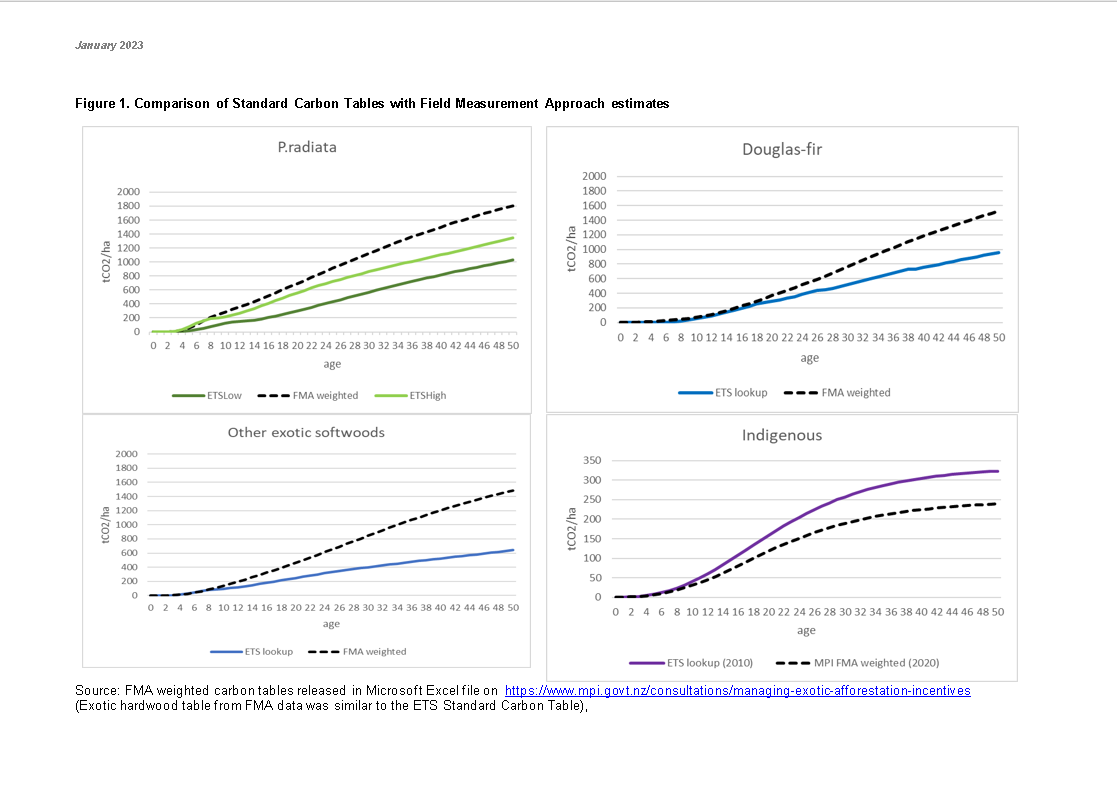Description
For owners with less that 100 ha of forest registered in the ETS, entitlement to carbon credits (NZUs) is calculated based on Standard Carbon Tables, which express the expected total carbon stock per hectare (expressed as tonnes of carbon dioxide) by age up to age 50.
This dataset provides a pointer to the extensive information on forestry in the ETS provided on the Ministry for Primary Industries' website and a brief description of the use of the tables and their use.
Date: January 2023 Version: v1
Owner: MPI is responsible for the Standard Carbon Tables, which are set out in the Climate Change (Forestry) Regulations 2022 on the New Zealand Legislation website.
Contact: Steve J Wakelin (Scion) for this Overview document. MPI is responsible for the ETS default Standard Carbon Tables in Climate Change (Forestry) Regulations 2022.
Link to report / paper
ETS Standard Carbon Tables (Overview document)
Preview Image

Dataset attributes
| Spatial extent |
Radiata pine carbon tables are provided for ten regions, while tables for the other four forest types are national. The radiata pine regions are defined in the legislation according to territorial authority boundaries before January 1990. |
|---|
| Spatial resolution |
By design, the tables are regional (radiata pine) or national (all other species). |
|---|
| Temporal extent |
The current ETS Standard Carbon Tables will apply until there is a change in legislation and the regulations are updated. The tables do not provide an opportunity to earn NZUs beyond age 50. |
|---|
| Temporal resolution |
The ETS Standard Carbon Tables are defined as carbon stocks by age, so that annual increments can be calculated. |
|---|
| Evaluation method (Validation) |
In terms of calculation of NZU entitlement, the ETS Standard Carbon Tables are 100% accurate for forest owners entitled to use them. However, they do not necessarily provide an accurate indication of the mean carbon sequestration expected from afforestation of any particular area or at a national level. Therefore they are unlikely to give an accurate estimate of NZUs that will be earned by an owner with over 100 ha registered in the ETS, who must measure plots under the Field Measurement Approach to derive Participant-Specific Carbon Tables. |
|---|
| Evaluation result (Numeric) |
|
|---|
| Evaluation result (Categorical) |
A comparison is provided between the Standard Carbon Tables and tables derived by MPI from weighted ETS Field Measurement Approach (FMA) data. |
|---|
| Uncertainty method |
|
|---|
| Uncertainty data format (Numeric) |
|
|---|
| Uncertainty data format (Categorical) |
|
|---|
Methodology
The exotic forest Standard Carbon tables are based on national Permanent Sample Plot data held by Scion. They are designed to be conservative since ETS participants are not liable for the loss of pre-afforestation biomass and soil carbon which New Zealand accounts for in international reporting, and the tables reflect prevailing mean harvest yields at the time they were prepared. The indigenous carbon forest table largely represents even-aged succession of mānuka after fire, with relatively high canopy cover. Sequestration rates on harsh sites that only just meet the 30% canopy cover threshold will be lower, while sequestration by some well managed native tree plantations on fertile, sheltered sites will be higher. Sequestration rates for all forest types beyond age 50 are less certain and not covered by the current tables.
Fitness for purpose / limitations
This table indicates whether the dataset is suitable for different types of questions at different scales.
Note: Users should carefully consider their purpose as this dataset may not be suitable.
|
Operational
| Absolute
| Relative
| Screening/scoping
|
| Block/farm |
Yes | Yes | Yes | Yes |
| Multi-farms(5+) |
Yes | Yes | Yes | Yes |
| Catchment |
Yes | Yes | Yes | Yes |
| National/regional |
Yes | Yes | Yes | Yes |
Caveat(s) |
Standard Carbon tables apply only to ETS participants with less than 100 ha registered. Their intended purpose is to allow the NZU entitlement of forest owners to be calculated, and hence potential carbon revenues to be estimated (assuming NZUs are sold). They do not necessarily provide an accurate estimate of actual carbon stocks or sequestration at block, farm(s), catchment or national levels, such as would be required for owners wth over 100 ha or for international reporting analyses. The tables are unlikely to be fit for these purposes. |
